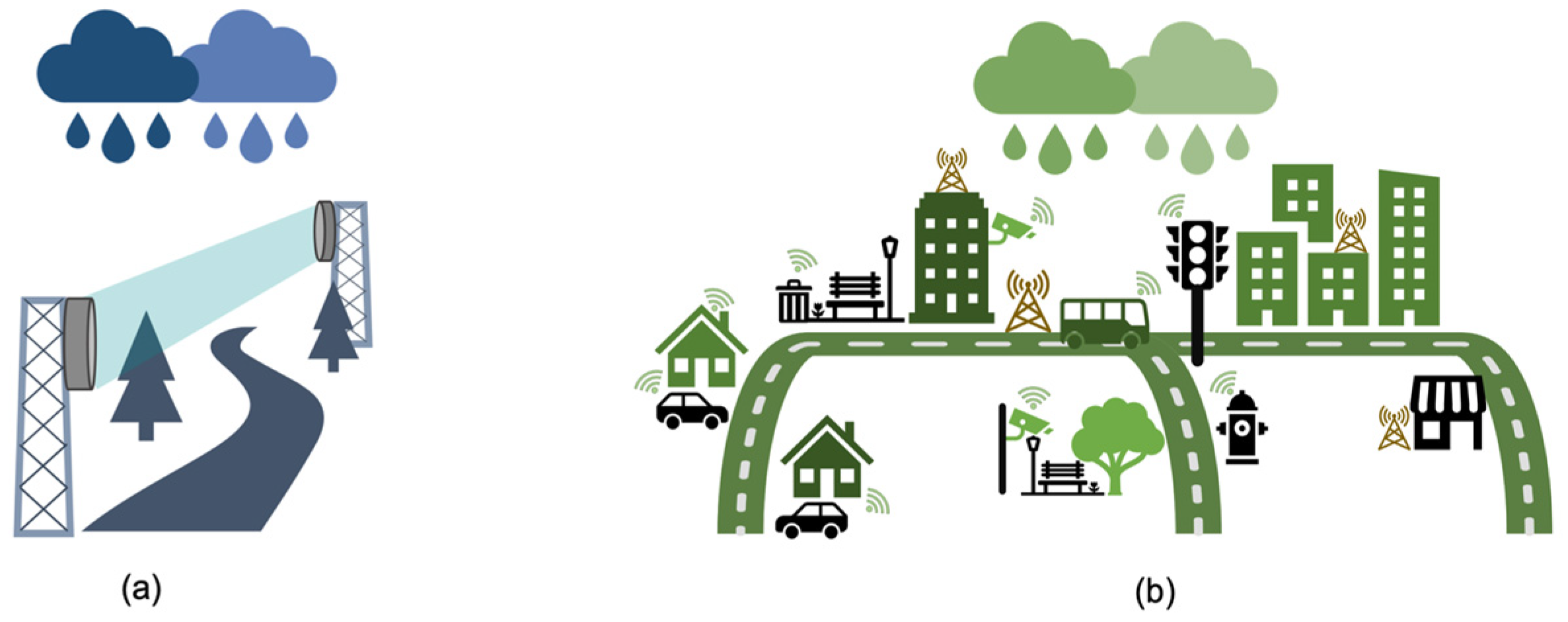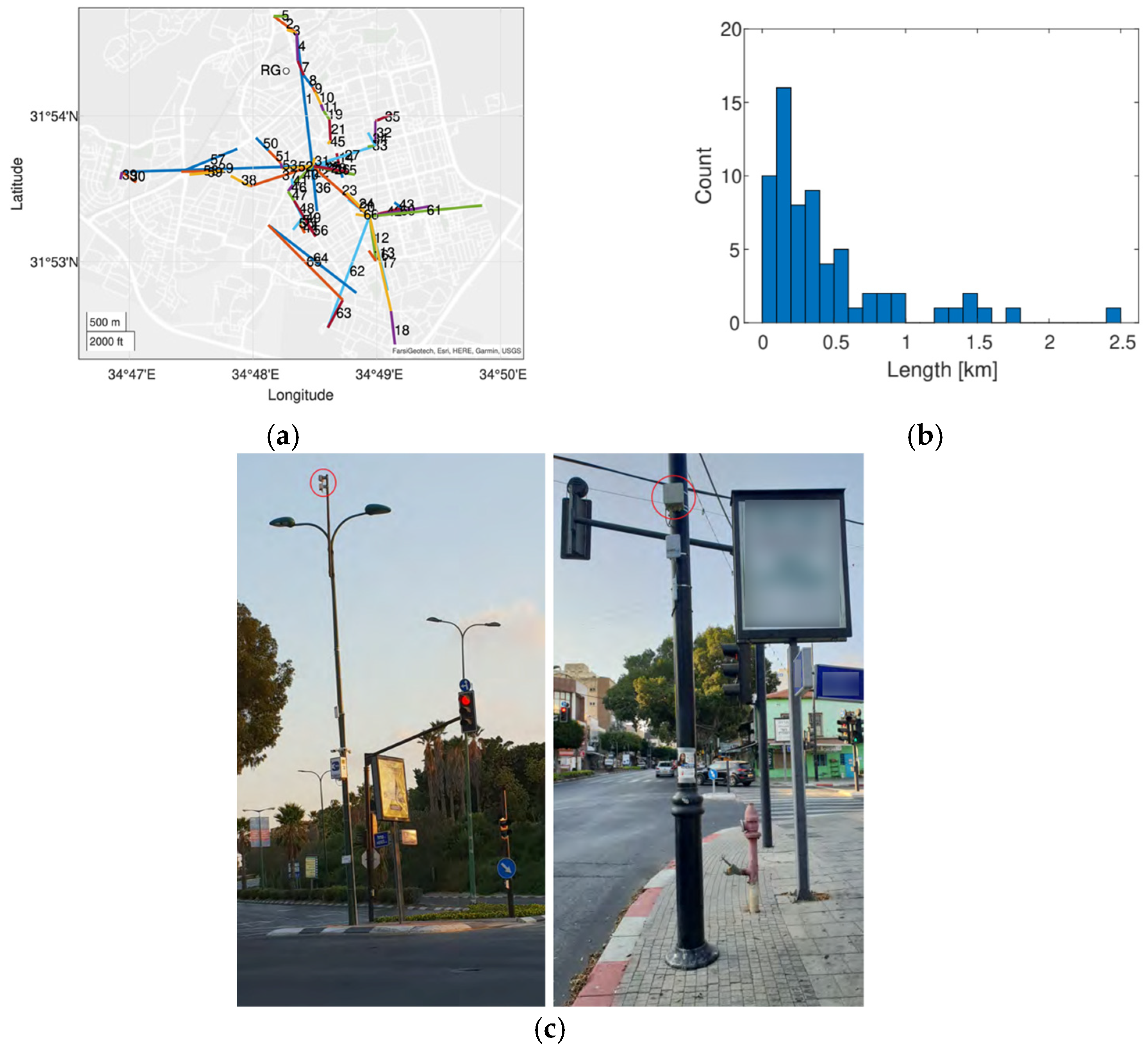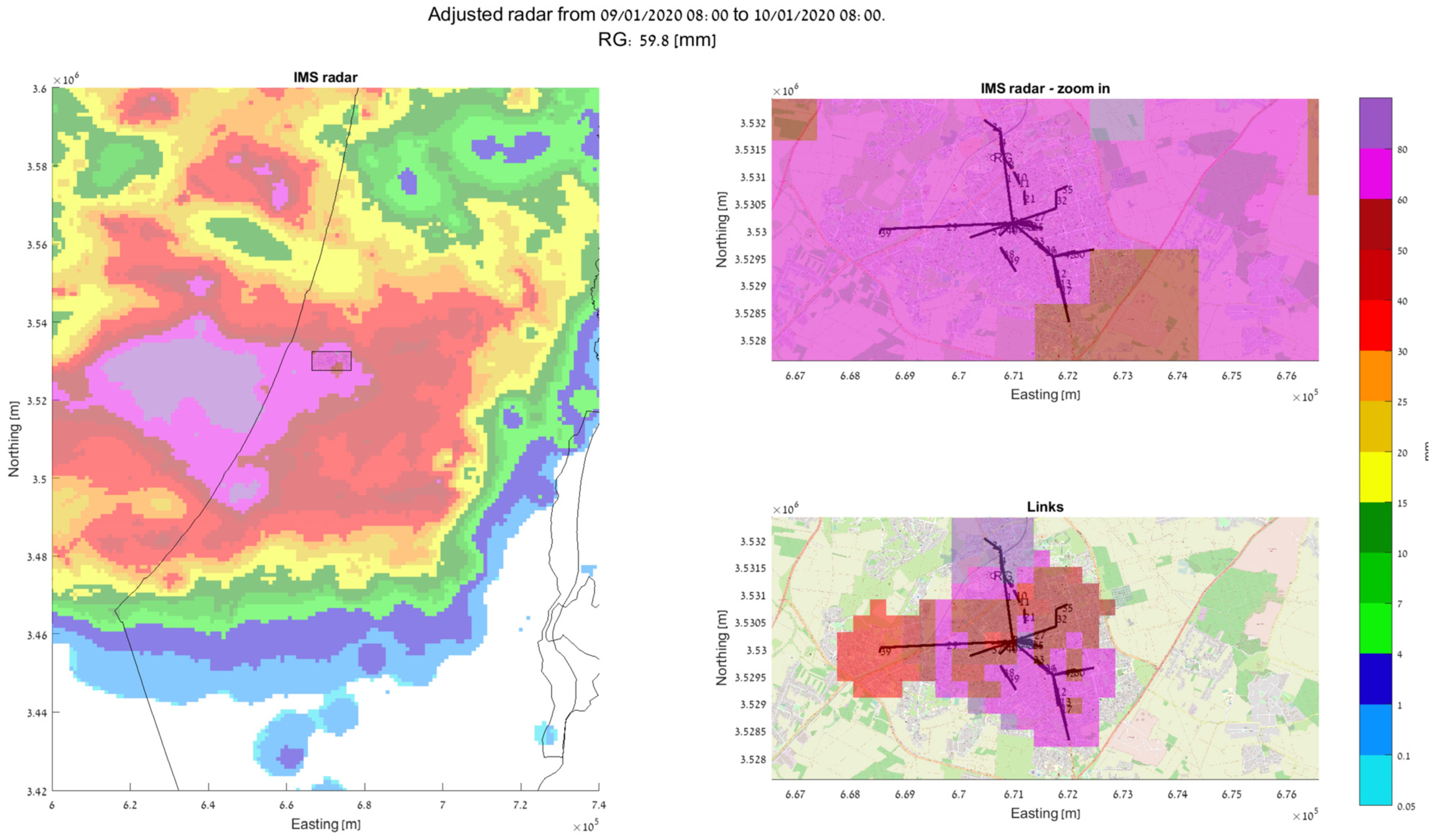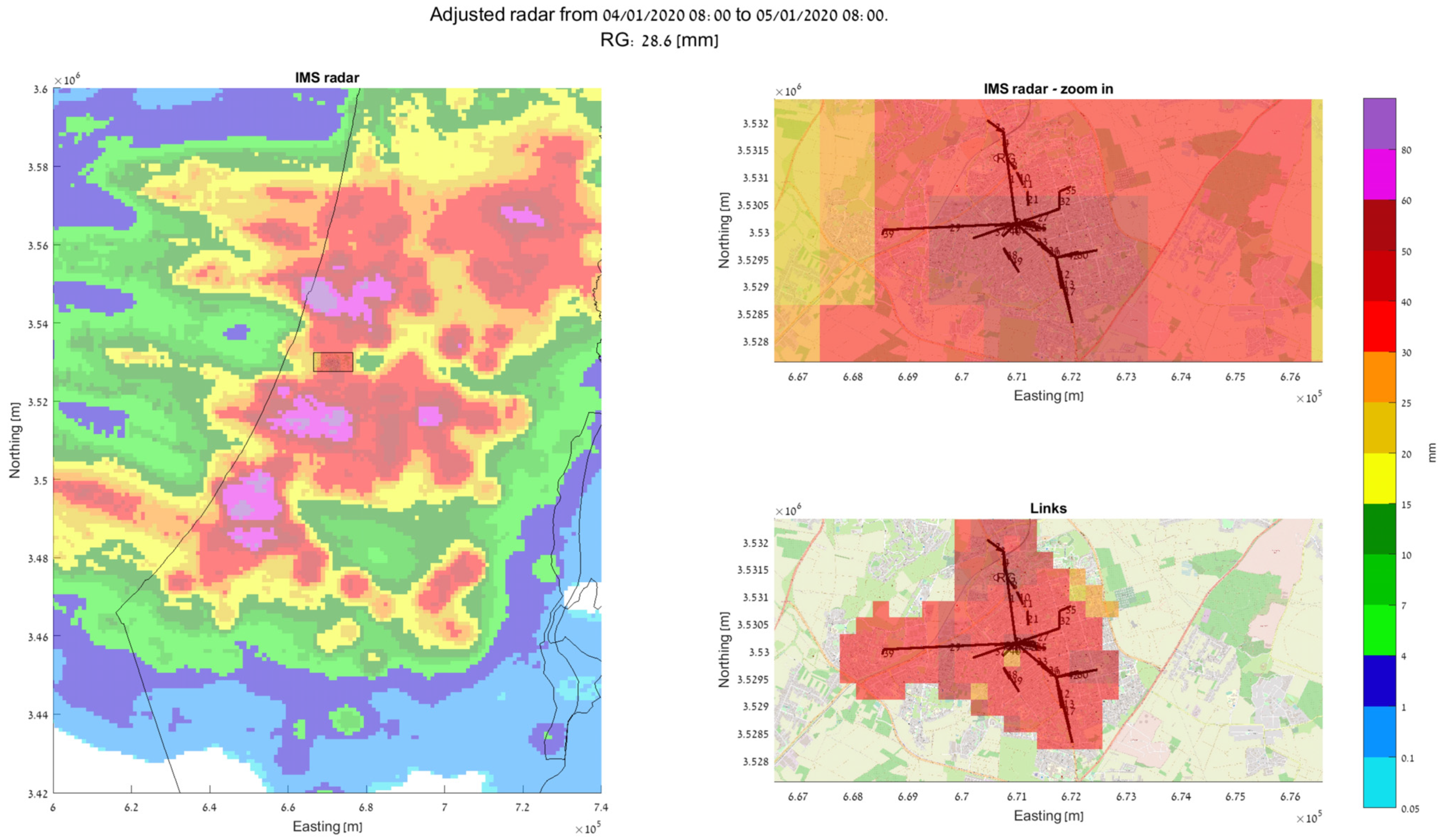Opportunistic Weather Sensing by Smart City Wireless Communication Networks
Abstract
:1. Introduction—Opportunistic Sensing of Weather
2. OISAC of Weather—Current Situation
Commercial Microwave and mmWave Links
3. OISAC in Smart Cities
4. Open Issues in Opportunistic ISAC and IoT
4.1. Non-Attenuation Measurements
4.2. Wireless Networks Quality of Service Optimization
5. Summary and Conclusions
Supplementary Materials
Author Contributions
Funding
Institutional Review Board Statement
Informed Consent Statement
Data Availability Statement
Acknowledgments
Conflicts of Interest
References
- Barrett, E.C.; Beaumont, M.J. Satellite rainfall monitoring for agrometeorology: Operational problems, practices and prospects. EARSeL Adv. Remote Sens. 1993, 2, 66–72. [Google Scholar]
- Raghavan, S. Radar Meteorology; Springer Science & Business Media: Berlin/Heidelberg, Germany, 2003. [Google Scholar]
- Levin, H.J. The Invisible Resource: Use and Regulation of the Radio Spectrum; RFF Press: Washington, WA, USA, 2011. [Google Scholar]
- Frey, T.L. The Effects of the Atmosphere and Weather on the Performance of a mm-Wave Communication Link. Appl. Microw. Wirel. 1999, 11, 76–81. [Google Scholar]
- Corke, P.; Wark, T.; Jurdak, R.; Hu, W.; Valencia, P.; Moore, D. Environmental wireless sensor networks. Proc. IEEE 2010, 98, 1903–1917. [Google Scholar] [CrossRef]
- Bevis, M.; Businger, S.; Herring, T.A.; Rocken, C.; Anthes, R.A.; Ware, R.H. GPS meteorology—Remote sensing of atmospheric water vapor using the Global Positioning System. J. Geophys. Res. 1992, 97, 15787–15801. [Google Scholar] [CrossRef]
- Messer, H.; Zinevich, A.; Alpert, P. Environmental monitoring by wireless communication networks. Science 2006, 312, 713. [Google Scholar] [CrossRef]
- Messer, H. Rainfall Monitoring Using Cellular Networks [In the Spotlight]. IEEE Signal Process. Mag. 2007, 3, 142–144. [Google Scholar] [CrossRef]
- Leijnse, H.; Uijlenhoet, R.; Stricker, J.N.M. Rainfall measurement using radio links from cellular communication networks. Water Resour. Res. 2007, 43. [Google Scholar] [CrossRef]
- Doumounia, A.; Gosset, M.; Cazenave, F.; Kacou, M.; Zougmore, F. Rainfall monitoring based on microwave links from cellular telecommunication networks: First results from a West African test bed. Geophys. Res. Lett. 2014, 41, 6016–6022. [Google Scholar] [CrossRef]
- Trapasso, L.M. Meteorological data acquisition in Ecuador, South America: Problems and solutions. GeoJournal 1986, 12, 89–94. [Google Scholar] [CrossRef]
- Gosset, M.; Kunstmann, H.; Zougmore, F.; Cazenave, F.; Leijnse, H.; Uijlenhoet, R.; Chwala, C.; Keis, F.; Doumounia, A.; Boubacar, B.; et al. Improving Rainfall Measurement in gauge poor regions thanks to mobile telecommunication networks. Bull. Am. Meteorol. Soc. 2015, 97, ES49–ES51. [Google Scholar] [CrossRef]
- Liu, A.; Huang, Z.; Li, M.; Wan, Y.; Li, W.; Han, T.X.; Liu, C.; Du, R.; Tan, D.K.P.; Lu, J.; et al. A survey on fundamental limits of integrated sensing and communication. IEEE Commun. Surv. Tutor. 2022, 24, 994–1034. [Google Scholar] [CrossRef]
- Janco, R.; Ostrometzky, J.; Messer, H. In-City Rain Mapping from Commercial Microwave Links—Challenges and Opportunities. Sensors 2023, 23, 4653. [Google Scholar] [CrossRef] [PubMed]
- Han, C.; Zhang, G.; Ji, B.; Huo, J.; Messer, H. On the Potential of Using Emerging Microwave Links for City Rainfall Monitoring. IEEE Commun. Mag. 2023, 61, 174–180. [Google Scholar] [CrossRef]
- De La Oliva, A.; Perez, X.C.; Azcorra, A.; Di Giglio, A.; Cavaliere, F.; Tiegelbekkers, D.; Lessmann, J.; Haustein, T.; Mourad, A.; Iovanna, P. Xhaul: Toward an integrated fronthaul/backhaul architecture in 5G networks. IEEE Wirel. Commun. 2015, 22, 32–40. [Google Scholar] [CrossRef]
- Cui, Y.; Liu, F.; Jing, X.; Mu, J. Integrating sensing and communications for ubiquitous IoT: Applications, trends, and challenges. IEEE Netw. 2021, 35, 158–167. [Google Scholar] [CrossRef]
- Liu, F.; Cui, Y.; Masouros, C.; Xu, J.; Han, T.X.; Eldar, Y.C.; Buzzi, S. Integrated sensing and communications: Toward dual-functional wireless networks for 6G and beyond. IEEE J. Sel. Areas Commun. 2022, 40, 1728–1767. [Google Scholar] [CrossRef]
- Giannetti, F.; Reggiannini, R. Opportunistic Rain Rate Estimation from Measurements of Satellite Downlink Attenuation: A Survey. Sensors 2021, 21, 5872. [Google Scholar] [CrossRef]
- Fencl, M.; Rieckermann, J.; Sykora, P.; Stransky, D.; Bares, V. Commercial microwave links instead of rain gauges: Fiction or reality? Water Sci. Technol. 2015, 71, 31–37. [Google Scholar] [CrossRef]
- Polz, J.; Chwala, C.; Graf, M.; Kunstmann, H. Rain event detection in commercial microwave link attenuation data using convolutional neural networks. Atmos. Meas. Tech. 2020, 13, 3835–3853. [Google Scholar] [CrossRef]
- Overeem, A.; Leijnse, H.; Uijlenhoet, R. Country-wide rainfall maps from cellular communication networks. Proc. Natl. Acad. Sci. USA 2013, 110, 2741–2745. [Google Scholar] [CrossRef]
- Graf, M.; El Hachem, A.; Eisele, M.; Seidel, J.; Chwala, C.; Kunstmann, H.; Bárdossy, A. Rainfall estimates from opportunistic sensors in Germany across spatio-temporal scales. J. Hydrol. Reg. Stud. 2021, 37, 100883. [Google Scholar] [CrossRef]
- Mishra, K.V.; Gharanjik, A.; Shankar, M.R.B.; Ottersten, B. Deep learning framework for precipitation retrievals from communication satellites. In Proceedings of the 10th European Conference on Radar in Meteorology and Hydrology, Ede-Wageningen, The Netherlands, 1–6 July 2018; Volume 7, p. 23. [Google Scholar]
- Ostrometzky, J.; Rafalovich, G.; Kagan, B.; Messer, H. Stand-Alone, Affordable IoT Satellite Terminals and Their Opportunistic Use for Rain Monitoring. IEEE Internet Things Mag. 2022, 5, 100–105. [Google Scholar] [CrossRef]
- Gubbi, J.; Buyya, R.; Marusic, S.; Palaniswami, M. Internet of Things (IoT): A vision, architectural elements, and future directions. Future Gener. Comput. Syst. 2013, 29, 1645–1660. [Google Scholar] [CrossRef]
- Mahmoud, R.; Yousuf, T.; Aloul, F.; Zualkernan, I. Internet of things (IoT) security: Current status, challenges and prospective measures. In Proceedings of the 2015 10th International Conference for Internet Technology and Secured Transactions (ICITST), London, UK, 14–16 December 2015; pp. 336–341. [Google Scholar]
- Swamy, S.N.; Jadhav, D.; Kulkarni, N. Security threats in the application layer in IOT applications. In Proceedings of the 2017 International Conference on i-SMAC (IOT in Social, Mobile, Analytics and Cloud) (i-SMAC), Palladam, India, 10–11 February 2017; pp. 477–480. [Google Scholar]
- Janco, R.; Ostrometzky, J.; Messer, H. Rain Estimation from Smart City’s E-band Links. In Proceedings of the 2022 IEEE 14th Image, Video, and Multidimensional Signal Processing Workshop (IVMSP), Nafplio, Greece, 26–29 June 2022. [Google Scholar]
- Ostrometzky, J. Statistical Signal Processing of Extreme Attenuation Measurements Taken by Commercial Microwave Links for Rain Monitoring; Tel Aviv University: Tel Aviv, Israel, 2017. [Google Scholar]
- ITU-R. P.838-3. Specific Attenuation Model for Rain for Use in Prediction Methods. 2005. Available online: https://www.itu.int/rec/r-rec-p.838-3-200503-i/en (accessed on 25 September 2024).
- Olsen, R.L.; Rogers, D.V.; Hodge, D.B. The aRb relation in the calculation of rain attenuation. IEEE Trans. Antennas Propag. 1978, 26, 318–329. [Google Scholar] [CrossRef]
- Goldshtein, O.; Messer, H.; Zinevich, A. Rain rate estimation using measurements from commercial telecommunications links. IEEE Trans. Signal Process. 2009, 57, 1616–1625. [Google Scholar] [CrossRef]
- Gunn, K.L.S.; East, T.W.R. The microwave properties of precipitation particles. Q. J. R. Meteorol. Soc. 1954, 80, 522–545. [Google Scholar] [CrossRef]
- Andersson, J.; Olsson, J.; van de Beek, R.C.; Hansryd, J. OpenMRG: Open data from Microwave links, Radar, and Gauges for rainfall quantification in Gothenburg, Sweden. Earth Syst. Sci. Data 2022, 14, 5411–5426. [Google Scholar] [CrossRef]
- Harel, O.; David, N.; Alpert, P.; Messer, H. The Potential of Microwave Communication Networks to Detect Dew—Experimental Study. IEEE J. Sel. Top. Appl. Earth Obs. Remote Sens. 2015, 8, 4396–4404. [Google Scholar] [CrossRef]
- Moshe, D.B.; Messer, H.; Nathan, R.; Sapir, N. Empirical Study on the Effect of Birds on Commercial Microwave Links. IEEE Access 2022, 10, 103819–103826. [Google Scholar] [CrossRef]
- Overeem, A.; Leijnse, H.; Uijlenhoet, R. Retrieval algorithm for rainfall mapping from microwave links in a cellular communication network. Atmos. Meas. Tech. 2016, 9, 2425–2444. [Google Scholar] [CrossRef]
- Ostrometzky, J.; Messer, H. Dynamic Determination of the Baseline Level in Microwave Links for Rain Monitoring from Minimum Attenuation Values. IEEE J. Sel. Top. Appl. Earth Obs. Remote Sens. 2018, 11, 24–33. [Google Scholar] [CrossRef]
- Habi, H.V.; Messer, H. Recurrent neural network for rain estimation using commercial microwave links. IEEE Trans. Geosci. Remote Sens. 2020, 59, 3672–3681. [Google Scholar] [CrossRef]
- Pudashine, J.; Guyot, A.; Petitjean, F.; Pauwels, V.R.N.; Uijlenhoet, R.; Seed, A.; Prakash, M.; Walker, J.P. Deep learning for an improved prediction of rainfall retrievals from commercial microwave links. Water Resour. Res. 2020, 56, e2019WR026255. [Google Scholar] [CrossRef]
- Pu, K.; Liu, X.; Xian, M.; Gao, T. Machine learning classification of rainfall types based on the differential attenuation of multiple frequency microwave links. IEEE Trans. Geosci. Remote Sens. 2020, 58, 6888–6899. [Google Scholar] [CrossRef]
- Covi, E.; Roversi, G. OpenRainER (1.0.0). 2024. Available online: https://zenodo.org/doi/10.5281/zenodo.10593848 (accessed on 25 September 2024).
- Wolff, W.; Overeem, A.; Leijnse, H.; Uijlenhoet, R. Rainfall retrieval algorithm for commercial microwave links: Stochastic calibration. Atmos. Meas. Tech. 2022, 15, 485–502. [Google Scholar] [CrossRef]
- Rubin, Y.; Rostkier-Edelstein, D.; Chwala, C.; Alpert, P. Challenges in Diurnal Humidity Analysis from Cellular Microwave Links (CML) over Germany. Remote Sens. 2022, 14, 2353. [Google Scholar] [CrossRef]
- David, N.; Alpert, P.; Messer, H. The potential of commercial microwave networks to monitor dense fog—Feasibility study. J. Geophys. Res. Atmos. 2013, 118, 11–750. [Google Scholar] [CrossRef]
- Cherkassky, D.; Ostrometzky, J.; Messer, H. Precipitation classification using measurements from commercial microwave links. IEEE Trans. Geosci. Remote Sens. 2013, 52, 2350–2356. [Google Scholar] [CrossRef]
- Ostrometzky, J.; Cherkassky, D.; Messer, H. Accumulated mixed precipitation estimation using measurements from multiple microwave links. Adv. Meteorol. 2015, 2015, 707646. [Google Scholar] [CrossRef]
- Ostrometzky, J.; Raich, R.; Bao, L.; Hansryd, J.; Messer, H. The wet-antenna effect—A factor to be considered in future communication networks. IEEE Trans. Antennas Propag. 2017, 66, 315–322. [Google Scholar] [CrossRef]
- Islam, M.R.; Tharek, A.R.; Din, J.; Chebil, J. Measurement of wet antenna effects on microwave propagation-an analytical approach. In Proceedings of the 2000 IEEE Asia-Pacific Microwave Conference, Sydney, Australia, 3–6 December 2000; pp. 1547–1551. [Google Scholar]
- Zheng, X.; Messer, H.; Wang, Q.; Xu, T.; Qin, Y.; Yang, T. On the potential of commercial microwave link networks for high spatial resolution rainfall monitoring in urban areas. Atmos. Res. 2022, 277, 106289. [Google Scholar] [CrossRef]
- Hadar, M.; Ostrometzky, J.; Messer, H. Parameter estimation of in-city frontal rainfall propagation. In Proceedings of the ICASSP 2020–2020 IEEE International Conference on Acoustics, Speech and Signal Processing (ICASSP), Barcelona, Spain, 4–8 May 2020. [Google Scholar]
- Janco, R. Rain Estimation from Smart City’s E-Band Links. Master’s Thesis, Tel Aviv University, Tel Aviv, Israel, 2022. [Google Scholar]
- Hadar, M. Smart-City E-Band Communication Network for Opportunistic Weather Sensing. Master’s Thesis, Tel Aviv University, Tel Aviv, Israel, 2020. [Google Scholar]
- Habi, H.V.; Messer, H. Uncertainties in short commercial microwave links fading due to rain. In Proceedings of the ICASSP 2020–2020 IEEE International Conference on Acoustics, Speech and Signal Processing (ICASSP), Barcelona, Spain, 4–8 May 2020; pp. 9006–9010. [Google Scholar]
- Joseph, F.J.J. IoT based weather monitoring system for effective analytics. Int. J. Eng. Adv. Technol. 2019, 8, 311–315. [Google Scholar]
- Sampathkumar, A.; Murugan, S.; Elngar, A.A.; Garg, L.; Kanmani, R.; Malar, A.C.J. A novel scheme for an IoT-based weather monitoring system using a wireless sensor network. Integr. WSN IoT Smart Cities 2020, 2020, 181–191. [Google Scholar]
- Shinde, S.R.; Karode, A.H.; Suralkar, S.R. Review on-IOT based environment monitoring system. Int. J. Electron. Commun. Eng. Technol. 2017, 8, 103–110. [Google Scholar]
- Ronkainen, H.; Edstam, J.; Ericsson, A.; Östberg, C. Integrated access and backhaul: A new type of wireless backhaul in 5G. Front. Commun. Netw. 2021, 2, 636949. [Google Scholar] [CrossRef]
- Zhang, Y.-P.; Wang, P.; Goldsmith, A. Rainfall effect on the performance of millimeter-wave MIMO systems. IEEE Trans. Wirel. Commun. 2015, 14, 4857–4866. [Google Scholar] [CrossRef]
- Leibovitz, G.; Messer, H. Estimating Absolute Humidity Using Latency Measurements Over CMLs: Challenges, Opportunities and Error Analysis. In Proceedings of the 2020 54th Asilomar Conference on Signals, Systems, and Computers, Pacific Grove, CA, USA, 1–4 November 2020; pp. 623–630. [Google Scholar]
- Ericsson Microwave Outlook. 2022. Available online: https://www.ericsson.com/4a81b8/assets/local/reports-papers/microwave-outlook/2022/ericsson-microwave-outlook-report-2022.pdf (accessed on 25 September 2024).
- Park, S.-G.; Kim, H.-L.; Ham, Y.-W.; Jung, S.-H. Comparative evaluation of the OTT PARSIVEL2 using a collocated two-dimensional video disdrometer. J. Atmos. Ocean. Technol. 2017, 34, 2059–2082. [Google Scholar] [CrossRef]
- Alberto, V.-G.; Sadhu, B.; Gu, X.; Tousi, Y.; Liu, D.; Reynolds, S.K.; Haillin, J.; Sahl, S.; Rexberg, L. Circuit and antenna-in-package innovations for scaled mmWave 5G phased array modules. In Proceedings of the 2018 IEEE Custom Integrated Circuits Conference (CICC), San Diego, CA, USA, 8–11 April 2018; pp. 1–8. [Google Scholar]
- Ericsson Technology Review Magazine. 2022. Available online: https://www.ericsson.com/4aaac2/assets/local/reports-papers/ericsson-technology-review/docs/2022/etr-magazine-2022-02.pdf (accessed on 25 September 2024).
- Kim, T.; Ramos, C.; Mohammed, S. Smart city and IoT. Future Gener. Comput. Syst. 2017, 76, 159–162. [Google Scholar] [CrossRef]
- Overeem, A.; Robinson, J.C.R.; Leijnse, H.; Steeneveld, G.-J.; Horn, B.K.P.; Uijlenhoet, R. Crowdsourcing urban air temperatures from smartphone battery temperatures. Geophys. Res. Lett. 2013, 40, 4081–4085. [Google Scholar] [CrossRef]
- Kadota, I.; Jacoby, D.; Messer, H.; Zussman, G.; Ostrometzky, J. Switching in the Rain: Predictive Wireless x-haul Network Reconfiguration. Proc. ACM Meas. Anal. Comput. Syst. 2022, 6, 1–26. [Google Scholar] [CrossRef]
- Bherwani, H.; Singh, A.; Kumar, R. Assessment methods of urban microclimate and its parameters: A critical review to take the research from lab to land. Urban Clim. 2020, 34, 100690. [Google Scholar] [CrossRef]
- Graf, M.; Chwala, C.; Polz, J.; Kunstmann, H. Rainfall estimation from a German-wide commercial microwave link network: Optimized processing and validation for 1 year of data. Hydrol. Earth Syst. Sci. 2020, 24, 2931–2950. [Google Scholar] [CrossRef]
- Zhang, P.; Liu, X.; Pu, K. Precipitation monitoring using commercial microwave links: Current status, challenges and prospectives. Remote Sens. 2023, 15, 4821. [Google Scholar] [CrossRef]





Disclaimer/Publisher’s Note: The statements, opinions and data contained in all publications are solely those of the individual author(s) and contributor(s) and not of MDPI and/or the editor(s). MDPI and/or the editor(s) disclaim responsibility for any injury to people or property resulting from any ideas, methods, instructions or products referred to in the content. |
© 2024 by the authors. Licensee MDPI, Basel, Switzerland. This article is an open access article distributed under the terms and conditions of the Creative Commons Attribution (CC BY) license (https://creativecommons.org/licenses/by/4.0/).
Share and Cite
Ostrometzky, J.; Messer, H. Opportunistic Weather Sensing by Smart City Wireless Communication Networks. Sensors 2024, 24, 7901. https://doi.org/10.3390/s24247901
Ostrometzky J, Messer H. Opportunistic Weather Sensing by Smart City Wireless Communication Networks. Sensors. 2024; 24(24):7901. https://doi.org/10.3390/s24247901
Chicago/Turabian StyleOstrometzky, Jonatan, and Hagit Messer. 2024. "Opportunistic Weather Sensing by Smart City Wireless Communication Networks" Sensors 24, no. 24: 7901. https://doi.org/10.3390/s24247901
APA StyleOstrometzky, J., & Messer, H. (2024). Opportunistic Weather Sensing by Smart City Wireless Communication Networks. Sensors, 24(24), 7901. https://doi.org/10.3390/s24247901








